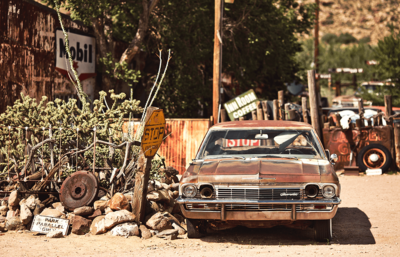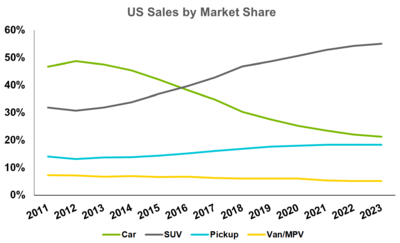Buh-Bye "Car" Bodystyle Forever?
‘Death of a car salesman’: Is the demise of the Car bodystyle a foregone conclusion?
Special to The Auto Channel
From LMC Automotive Blog
By David Franklin, Analyst
America's Vehicle Forecasts
That SUVs have risen to dominate the US market is a well-established fact, but, as analysts, we are often asked whether the Car bodystyle will ever make a resurgence, or is it destined to fall out of favour entirely?
Back in 2012, with the Great Recession firmly in the rear-view mirror, the Car segment – encompassing sedans, hatchbacks, convertibles, wagons and coupés – accounted for 49% of all US sales, with SUVs trailing behind in second place on 31%. But the market structure began to change when buyers who had delayed purchases in the immediate aftermath of the recession retired their vehicles.
Economic stability meant that consumers were willing to spend a little more on a new vehicle, with further encouragement coming from attractive leasing options and near 0% interest rates. Although slightly costlier than their Car counterparts in the same segment, SUVs had become a viable option.
A further obstacle to joining the SUV club was removed when fuel prices in the US dropped below US$3.00 in the second half of 2014, and have stayed at that level ever since. With fuel prices set to remain stable over the longer term, some of the financial burden of owning an SUV has been alleviated. Not only that but improvements in powertrain technologies have made it possible to shift away from large gas-guzzling engines to smaller-displacement boosted engines. Today, it is possible to own an SUV and save money at the pump, while also making a positive environmental impact. The improvements in both light weighting and powertrains, meanwhile, have narrowed the gap in fuel efficiency benefits between the Car and SUV bodystyles.
Vehicle safety, particularly for families, has become a far more important concern than ever before. And as the number of SUVs on the road has proliferated, more and more consumers are subscribing to the notion that there is safety in numbers. One could argue that SUV buyers are simply following a trend, but it may be more accurate to say that they are looking to improve their chances of surviving an accident by matching the size of other vehicles on the road.
OEMs helped to fuel this trend by expanding and improving their SUV product lines. Given that they offer better margins than Cars, boosting their SUV (and Pickup) portfolios was an obvious and necessary move as profits took precedence over market share gains.
The numbers speak for themselves. In 2012, 32 new car models entered the US market, compared to seven SUVs. Six years later, in 2018, the balance shifted as 16 new SUVs hit the US market, versus just five new car models.
By 2020, for the first time this century, SUVs will make up more than 50% of total US sales. But as the bodystyle has already been dominating market share for three years now, this projection is perhaps less of a surprise than an inevitability.
Returning to the question of a possible renaissance for the Car bodystyle, the answer is that it is unlikely. Much of the momentum in favour of SUVs will continue and there is little sign of the trend abating any time soon.
The arguments are fairly persuasive. Firstly, a Small or Compact SUV now costs roughly the same as a Compact or Midsize Car. Secondly, fuel prices should not fluctuate in any dramatic way, but even if they do, ongoing improvements in technology will ensure that SUVs become increasingly more fuel efficient. And with alternative powertrains being developed across the industry, the disparity in fuel efficiency will continue to diminish. Thirdly, the pursuit of safety will propel ever increasing numbers of buyers to choose a vehicle of a similar size and ride height to so many of those already on the road. Fourthly, we have already seen the Detroit Big Three abandon all development in the Car sector. And although some OEMs will maintain their current portfolios for the time being, swathes of new SUV models will soon find their way into the market as virtually every brand strives to remain competitive in this increasingly fragmented sector.
Our view is that the current focus on autonomy and ridesharing will likely only accelerate the switch away from Cars, although not necessarily to SUVs. There are clear arguments in favour of SUVs, however, given their roomier interiors. When it comes to ridesharing, the key factor is to accommodate larger groups of passengers as comfortably as possible. And as autonomous driving grows in prevalence, an SUV certainly lends itself far better to the leisure needs of drivers than a Car.




